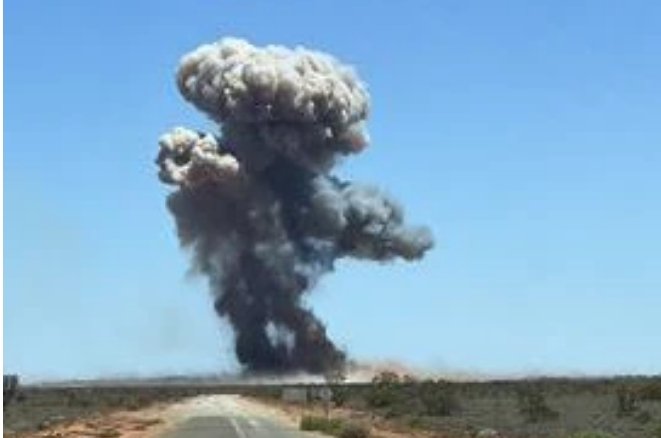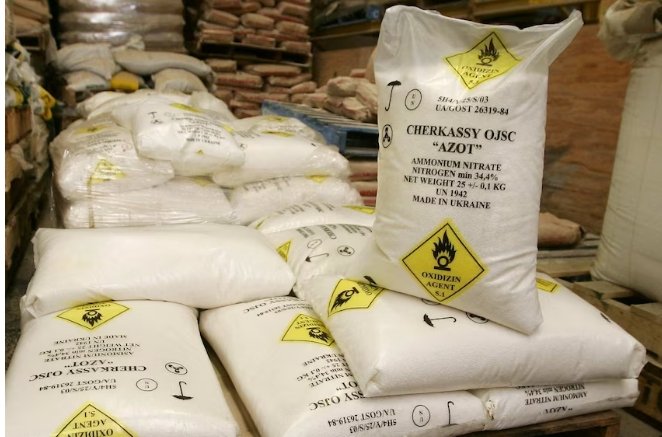SAFETY REGULATIONS FOR AMMONIUM NITRATE STILL PLAYING CATCHUP
“Nitrate trucks”—a special Ngaarda Investigates report
Paul Cleary and Cassie Ariuu
On most days of the week, there are about 60 road trains moving the explosive substance ammonium nitrate (AN)* to mine sites around Western Australia, and in the past 20 months alone, four of these vehicles have crashed in remote parts of the state.
The most recent accident last October killed three people and started a blaze so hot that fire crews couldn’t get near it for two days. A second accident in late 2022 near the Gruyere gold mine involved an explosion that left a 17m-wide crater in the road and scattered shrapnel up to 800 metres away from the centre of the blast.
An accident near New Norcia in June 2023 forced the evacuation of 100 residents, including 9 monks, and the fourth occurred in August 2023 near the mining town of Newman. In all four accidents, police imposed a 2-kilometre exclusion zone around each site.
Credit: The crater left by the Laverton blast in October 2022.(Supplied: DMIRS)
The WA government says these truck movements are safe, but the 2022 explosion in the goldfields triggered an overhaul of safety regulations that is still pending. The government told Ngaarda Media in December that the new regulations would be in place by March or April this year, but consultation on a Code of Conduct and drafting of regulations are still underway. The Code of Conduct outlines minimum requirements in the areas of fire-fighting equipment, driver training and monitoring of tyre temperature. In the case of the latter, companies are not required to have automatic equipment to monitor tyre temperature as it can be done manually using a thermal imaging camera.
Traditional owner Rex Parker is a Banjima and Nyiyaparli man who lives in the Youngalena community near Karijini National Park—about 4 hours drive inland and 20km from last October’s crash site. He says the community constantly sees the shipments of what they call “nitrate trucks” including those heading to FMG’s Solomon hub mine located 70km down the road. This is where FMG has mined $50 billion in iron ore from Yindjibarndi country without the consent of the traditional owners.
In an interview with Ngaarda Media, Mr Parker called for the public to be informed of these shipments and for them to have escort vehicles.
Credit: Residents were warned to stay inside and turn off their air-conditioning after a cloud of hazardous smoke was blown into the air.(Supplied: Facebook)
Current regulations, and those being developed, do not require the measures Mr Parker has called for. The AN shipments only require a small yellow sign at the back of the vehicle that displays the words ‘Ammonium Nitrate’ alongside a yellow triangle that says ‘Oxidising Agent 5.1’ inside, and an instruction to call 000 in case of emergency.
Iain Dainty, Director WorkSafe director of Petroleum Safety and Dangerous Goods, told Ngaarda Media in December that 1.1 million tonnes of AN was trucked around WA each year, but at an industry conference last year he increased that estimate to greater than 1.2 million tonnes. He said the truck movements covered “millions of kilometres by road”.
Mr Dainty says the proposed regulations will require road trains to carry better fire-fighting equipment so that fires can be quickly extinguished, along with wheel and hub temperature monitoring. In the case of the Goldfields explosion in 2022, a tire caught fire and the driver wasn’t able to extinguish it. He saved his life by decoupling the trailers from the prime mover and driving a safe distance away before the AN exploded.
In a presentation last month to an industry conference, Mr Dainty said the stronger regulations would also involve practical training in fire fighting for drivers, and the WA government would liaise with the National Transport Commission to seek “national support for change”.
It seems that WA is leading the spate of accidents has prompted WA to take the lead on reform, but other states are yet to take action. An accident involving an AN road train in north Queensland earlier this year forced police to impose a 5km exclusion zone, and in 2014 a police officer and four firefighters were among those hospitalised after a truck carrying ammonium nitrate rolled over and exploded near Charleville in south-west Queensland. The explosion destroyed a section of a bridge and left behind a huge crater.
Mr Dainty told Ngaarda Media there isn’t a legal requirement for transport companies to notify the government of AN shipments, but they use satellite technology to track movements.
“There isn’t a legal requirement [to notify the government], but there is for all operators to know where their product is at all times,” he told Ngaarda Media.
Mr Dainty said Worksafe has an audit program that targets about 35 licensed operators. “It is strict,” he said. “The vehicle operator has a duty of care to make sure the vehicle is maintained.”
But when asked if the audit program covered issues like driver fatigue, Mr Dainty said “it does and it doesn’t”. He said Worksafe managed the Dangerous Goods Safety Act, which did not cover fatigue.
Most of the AN trucked around WA comes from the CBSP plant in Kwinana, owned by the Wesfarmers giant. It is possible that some of this output could be shipped rather than put on the road, but the company declined to comment whether it was looking at this option.
Mr Parker says the that while the AN shipments going past the community are a real concern, they are just one of many impacts that the community has to live with given its location in a region where mining activity has increased 5-fold over the past 20 years.
In a further statement to Ngaarda Media, Mr Dainty said: “The process of drafting the amendments has started. Drafting is being conducted by the Parliamentary Counsel’s Office in consultation with WorkSafe. The draft Code of Practice was released for public comment on 31 May and will close on 12 July. WorkSafe will then analyse the feedback, further develop the code, and finalise the regulations.”
*AN comes in three forms. Ammonium nitrate emulsions (ANE), which exploded at the Gruyere accident in 2022; solid ammonium nitrate (AN) prill, which is a pellet that was involved in the other three accidents. A third form is known a ammonium nitrate solutions.
Credit: The effects of ammonium nitrate explosions have been devastating.(Reuters: Tim Wimborne)



